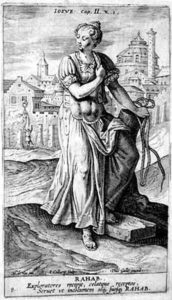
In chapter two of James we find a classic New Testament statement regarding the relationship between faith and works. “As the body without the spirit is dead, so faith without works is also dead” (v. 26). The New Testament church was not unlike the church of today, it seems: it struggled to make its walk match its talk. James set out to help the church find a dynamic, living faith centered in Jesus Christ – alive in the grace of God, and active in making his wonderful grace known.
Here in chapter two, James turns our attention to a pair of Old Testament examples of dynamic, Biblical, living faith. The first is Abraham — no surprise there. Abraham was the great father of the nation of Israel and an inspiration to Abrahamic peoples to this very day. But the second is, shall we say, somewhat less inspiring. James recommends the harlot Rahab of Jericho. This woman was “considered righteous,” James tells us — and “in the same way” as Abraham (2:25 NIV). At one crucial juncture, at least, her life came to match her faith. By the grace of God she made grace known.
You will, perhaps, remember the story (cf. Joshua 2). The spies of Israel were scouting Jericho as they prepared to enter Canaan following many years in the wilderness. Before long, however, they were found out — and found themselves on the lam. But Rahab lived in Jericho, too. She lived in a hole in the wall — a hollow, literally, in the outer wall of the city. And here the spies found her. They were looking, I suppose, for an out-of-the-way place, away from their pursuers in the streets of the city. And perhaps a window out of town. They found both with Rahab.
For her part, Rahab found deliverance when the city of Jericho eventually fell. And she found much more. Rahab the harlot found a place in the mission of God. When the mission of God came knocking at her door, she opened. She took her place in the cause. She became a part of the story, just like Abraham.
Well, not exactly like Abraham, perhaps.
Abraham’s obedience is premeditated over many days as he prepares for a singular heroic sacrifice (James 2:21; cf. Genesis 22). Rahab’s obedience seems spontaneous and unexpected, occasioned by spies knocking at her door. Abraham’s obedience occurs on the top of a mountain; Rahab’s obedience takes place in a hole in the wall. Abraham’s obedience unfolds with high drama, high cultic imagery, and under the watchful eye of the Father in heaven. It resolves in a dramatic heavenly intervention. It becomes a touchstone and emblem for an entire nation. Rahab’s obedience, on the other hand, unfolds on the run, and with dusty, every-day imagery. The Father’s eye is surely watching here, too. But the nearer “eye,” it seems, belongs to the anxious authorities in Jericho. And we don’t know how, exactly, the entire episode concludes. Rahab fades from view almost entirely. Until we find her long after, become a heroine (cf. Matthew 1:5, Hebrews 11:31, James 2:25).
Abraham the patriarch and Rahab the harlot heroine — James sets them side by side. Both redeemed by grace; both commissioned to make grace known.
So if you are feeling, sometimes, heroic or a little grand, consider the adventures of our heroic patriarch Abraham. God may lead you to a mountaintop and some spectacular act of mission and obedience. But if you live your life in a hole in the wall — if your circumstances are less than ideal and your narrative less than consistently heroic – take encouragement from the example of our sister Rahab. The mission of God had a role for her, too. Sometimes, you see, God’s mission comes literally knocking at the door. And if we are ready, if only we will open — we may enter the wonderful story, too.
well done Chuck
Thanks for your comment, Richard! What do you know? Someone has read an article on wmpl.org!